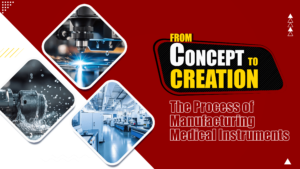Behind every medical procedure, diagnosis, and treatment lies a complex and intricate world of medical instruments. From the simplest scalpel to the most advanced imaging device, each instrument plays a crucial role in healthcare delivery.
The journey of manufacturing medical instruments begins with a clear understanding of clinical needs and technological possibilities. Engineers and designers collaborate closely with healthcare professionals to conceptualise instruments that address specific medical challenges. This phase involves extensive research, brainstorming, and prototyping to refine ideas into practical designs. CAD (Computer-Aided Design) software is often used to create detailed 3D models that guide the development process.
Once a design is finalised, the next critical step is selecting appropriate materials. Medical instruments must meet stringent requirements for biocompatibility, durability, and sterilisation compatibility. Manufacturers carefully choose materials such as stainless steel, titanium alloys, and medical-grade plastics that can withstand the rigours of healthcare environments. Each material undergoes rigorous testing to ensure it meets regulatory standards and performs reliably under clinical conditions.
Precision is paramount in medical instrument manufacturing. Advanced manufacturing techniques such as CNC (Computer Numerical Control) machining, laser cutting, and additive manufacturing (3D printing) are employed to achieve intricate designs with micron-level accuracy. CNC machines precisely carve components from raw materials, while laser cutting ensures clean and precise edges. Additive manufacturing allows for the creation of complex geometries not feasible with traditional methods, revolutionising the production of customised instruments.
Assembly of medical instruments is a meticulous process that demands attention to detail and adherence to strict protocols. Components manufactured through various processes are carefully inspected, assembled, and tested to ensure they meet design specifications. Quality assurance measures, including visual inspections, functional testing, and sterilisation validation, guarantee that each instrument performs reliably and safely in clinical settings.
Regulatory compliance is a cornerstone of medical instrument manufacturing. Manufacturers must navigate a complex landscape of regulations and standards set by health authorities such as the FDA (Food and Drug Administration) in the United States or the CE marking requirements in Europe. Compliance ensures that instruments meet safety, efficacy, and quality standards before they can be marketed and used in healthcare settings. Regular audits and inspections ensure ongoing adherence to regulatory requirements.
Once quality assurance and regulatory compliance are confirmed, medical instruments are carefully packaged to maintain sterility and integrity during storage and transportation. Packaging materials must provide adequate protection against contamination and physical damage. Manufacturers collaborate with logistics partners to ensure timely delivery to healthcare facilities worldwide, ensuring that instruments arrive ready for use in clinical procedures.
Manufacturing medical instruments extends beyond production; it includes ongoing training and support for healthcare professionals. Manufacturers provide comprehensive training programs to educate users on the proper handling, maintenance, and usage of instruments. Technical support teams are available to troubleshoot issues and provide assistance to ensure optimal performance in clinical settings. This commitment to customer support fosters confidence among healthcare providers in the reliability and efficacy of the instruments they rely on.
The process of manufacturing medical instruments is not static; it is a continuous journey of improvement and innovation. Manufacturers actively seek feedback from healthcare professionals and invest in research and development to enhance existing products and develop new solutions. Advances in materials science, robotics, artificial intelligence, and digital health are driving the next generation of medical instruments, promising improved patient outcomes and more efficient healthcare delivery.
Manufacturing medical instruments is a complex blend of science, technology, precision, and dedication. From initial concept to final product, each instrument undergoes a meticulous journey that ensures it meets the highest standards of quality, safety, and performance. The collaborative efforts of engineers, designers, healthcare professionals, and regulatory bodies ensure that these instruments contribute to better healthcare outcomes and enhance the quality of life for patients worldwide.
visit our website now now to know more.

